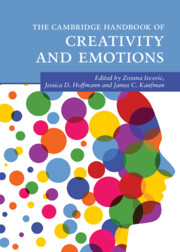Book contents
- The Cambridge Handbook of Creativity and Emotions
- Cambridge Handbooks in Psychology
- The Cambridge Handbook of Creativity and Emotions
- Copyright page
- Dedications
- Contents
- Figures
- Tables
- Contributors
- Acknowledgments
- Creativity and Emotions
- Part I Methods in the Study of Creativity and Emotions
- Part II The Development of Creativity
- Part III Emotions and the Creative Person
- Part IV Emotions and Creative Products
- 17 Emotional Creativity
- 18 Affective Factors in Dark Creativity
- 19 For Emotion’s Sake … The Centrality of Emotions in the Art Experience
- 20 The Affective Benefits of Creative Activities
- 21 Everyday Creativity as a Pathway to Meaning and Well-Being
- 22 Creative Arts Therapies
- 23 Developing Emotion Abilities through Engagement with the Arts
- Part V Emotions and Creativity at School and Work
- Index
- References
20 - The Affective Benefits of Creative Activities
from Part IV - Emotions and Creative Products
Published online by Cambridge University Press: 16 February 2023
- The Cambridge Handbook of Creativity and Emotions
- Cambridge Handbooks in Psychology
- The Cambridge Handbook of Creativity and Emotions
- Copyright page
- Dedications
- Contents
- Figures
- Tables
- Contributors
- Acknowledgments
- Creativity and Emotions
- Part I Methods in the Study of Creativity and Emotions
- Part II The Development of Creativity
- Part III Emotions and the Creative Person
- Part IV Emotions and Creative Products
- 17 Emotional Creativity
- 18 Affective Factors in Dark Creativity
- 19 For Emotion’s Sake … The Centrality of Emotions in the Art Experience
- 20 The Affective Benefits of Creative Activities
- 21 Everyday Creativity as a Pathway to Meaning and Well-Being
- 22 Creative Arts Therapies
- 23 Developing Emotion Abilities through Engagement with the Arts
- Part V Emotions and Creativity at School and Work
- Index
- References
Summary
Engaging in everyday creative activities improves affect, health, and well-being. In this chapter, we examine the affective benefits of both artistic and non-artistic creative activities and the emotion regulation strategies used to achieve these benefits. Considerably more research has examined the affective benefits of artistic than non-artistic activities. The existing studies reveal several distinct emotion regulation strategies used in creative activities – approach, avoidance, and self-development – with the use of these strategies differing by activity. The studies also reveal a clear difference in the affective goals for artistic versus non-artistic creative activities. Artistic activities are used to reduce negative affect whereas non-artistic activities are used to enhance or maintain positive affect. Further research is needed to determine whether this difference is genuine or an artifact of study design. Additional work is also needed to determine the underlying mechanisms accounting for how these activities improve affect and thereby regulate our emotions. We conclude with recommendations for further research in this area.
- Type
- Chapter
- Information
- The Cambridge Handbook of Creativity and Emotions , pp. 376 - 393Publisher: Cambridge University PressPrint publication year: 2023
References
- 1
- Cited by



